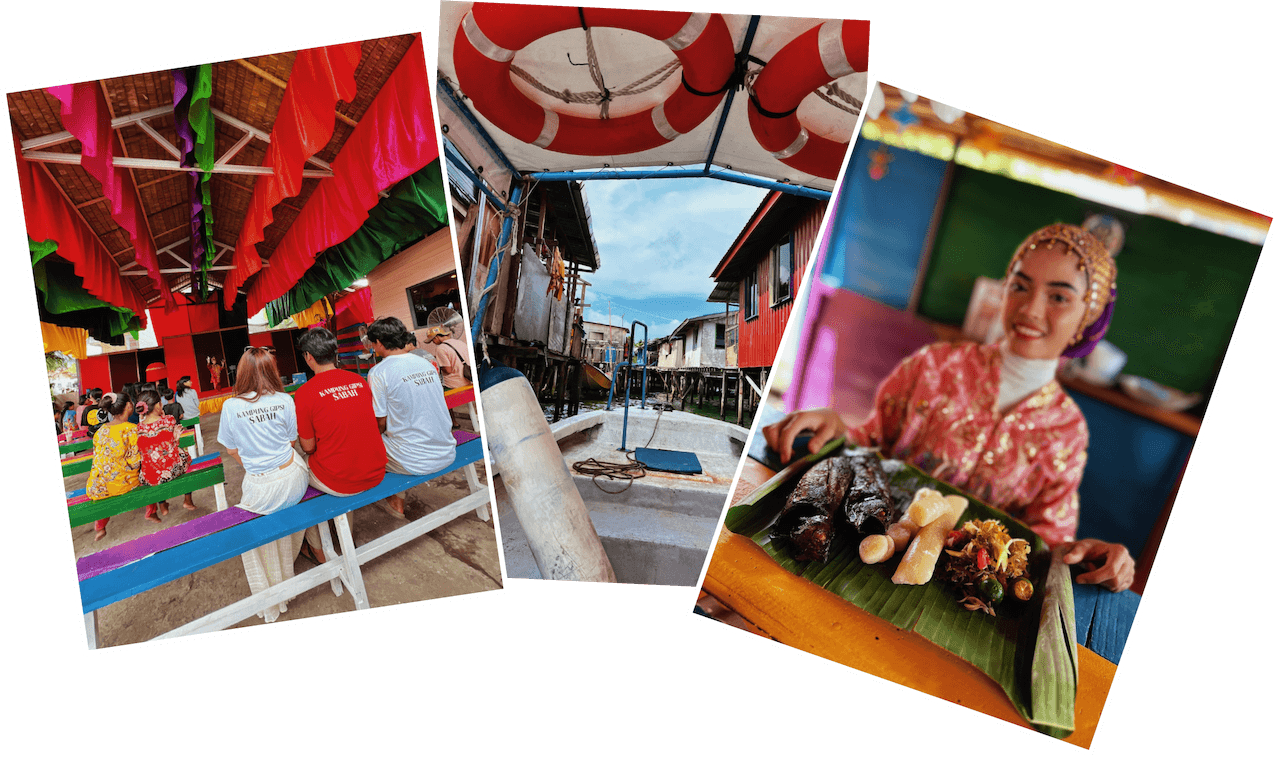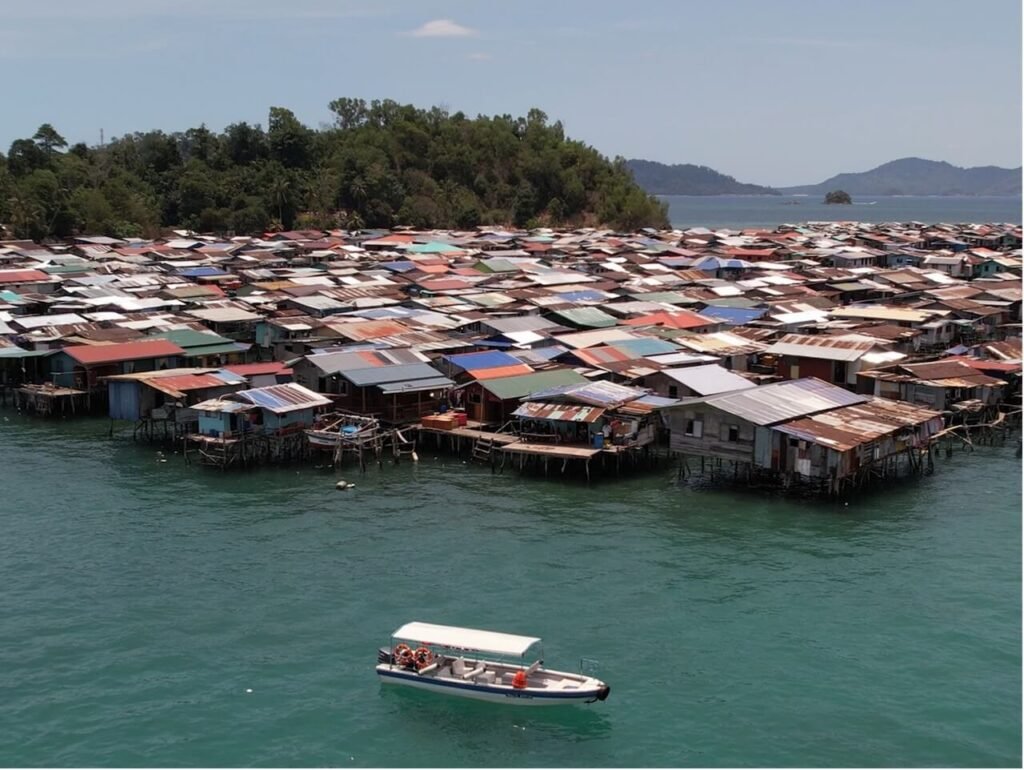kampung gipsi sabah cultural tour
Explore the Unique Culture of Bajau in Kota Kinabalu, Sabah

About Us
Kampung Gipsi Sabah Cultural Tour
Kampung Gipsi Sabah is a cultural village located in the heart of the beautiful island of Kota Kinabalu, Sabah. It offers a unique and enriching experience, allowing tourists to immerse themselves into the lives of the Bajau including sightseeing Bajau water village, learning about their maritime culture, experiencing and enjoying traditional cultural performance. The cultural village is only a 20-minute drive from the airport and situated near many international hotels. You can embark on your journey here from Jesselton Port is only a 5-minute boat ride. Another alternative where you can take a 10-minute boat ride to Kampung Gipsi Sabah from famous Pulau Sapi, Pulau Mamutik and Tunku Abdul Rahman Park. The Bajau, were one of the maritime communities of ancient Southeast Asia. The open ocean is the place of the Bajau’s cultural roots, sacred home, and sense of self, living on a boat or in a water village. Known as the Kings of Divers, the ocean is their home and heaven. This almost extinct minority can be found on the gem of Borneo Island.
Activities
Experience Authentic Bajau Culture with Kampung Gipsi Activities

Bajau Water Village Sightseeing
The Bajau, an indigenous maritime people who primarily live in the waters off the coast of Malaysia. Their unique way of life, including water off the borneo island in Sabah, offers a fascinating sightseeing experience for travellers interested in cultural and eco-tourism. Expect to see the Bajau live on modern and traditional houseboats known as “lepa-lepa” or in stilt houses built over shallow waters. These structures are ingeniously designed to withstand the maritime environment. The Bajau have distinct cultural practices and traditions. Visiting Bajau water villages offers a unique cultural and ecological experience, providing insight into the lifestyle of one of the world’s last remaining maritime nomadic communities. Through respectful and responsible tourism, tourists can enjoy the beauty and richness of Bajau culture while contributing to the preservation of their way of life.

Traditional Bajau Cuisine
Bajau diet primarily based on seafood reflecting their resourcefulness and deep connection to the sea. Traditional dishes including grilled fish, salted fish, raw fish salad, seaweed salad, latok (green marine grapes), putu (wrapped, mashed and steam cassava or tapioca) and panggi-panggi cake (cassava or tapioca confectionery dessert). Modern influences such as the integration with local cuisines plus economic and environmental challenges are impacting traditional food sources, leading to adaptation in their diet and cooking methods create more diverse fusion cuisine incorporates elements from Malaysian cooking. The cuisine of the Bajau is a testament to their adaptability and profound connection to the sea. It is characterized by its simplicity, reliance on fresh and locally available ingredients, and the communal nature of food preparation and consumption.

Traditional Bajau Cultural Performance
The Bajau, known for their maritime culture, have a rich tradition of music, dance, and performance that reflects their deep connection to the sea and their way of life. Traditional performances play a significant role in their cultural heritage, often serving as expressions of community, storytelling, and spiritual beliefs. The Igal-Igal dance, sometimes referred to simply as Igal, is a traditional dance of the Bajau people. It is a graceful and expressive dance that captures the essence of their maritime culture and lifestyle. The dance is often performed during important community events, festivals, and celebrations. It is also often performed during wedding ceremony or welcoming the return of warrior. The movement of the dance resembles of a moving snake/limbless movement. During the wedding ceremony, money will be rewarded to best dancers by placing notes in between their fingers. While traditional performances remain a cornerstone of the Bajau culture, modern influences have also made their mark such as fusion performances incorporate modern instruments and style, tourism and cultural show to showcase their rich heritage and ongoing efforts to document and preserve traditional Bajau music, dance and oral traditions so that the these cultural practices are not lost. The traditional performances of the Bajau are a vibrant and essential part of their cultural identity, reflecting their seafaring heritage, communal values, and spiritual beliefs. Through music, dance, and storytelling, they continue to celebrate and preserve their unique cultural legacy.

Bajau Traditional Costume
The traditional costume reflects their unique maritime culture and heritage. Their traditional attire varies slightly depending on their specific community and location, but here are some common elements. The men’s traditional costume consists of Baju Melayu where an outfit consisting of a long-sleeved shirt and trousers. For formal occasions, the shirt might be ornately embroidered match together with the Sarong or Lungi and headgear. As for the women’s traditional costume consists of Baju Kurung where the traditional outfit similar to the Baju Melayu but tailored for women. It includes a long-sleeved tunic paired with a long skirt match together with the Sarong or Pareo, headscarf or Hijab and accessories. The common features including colors and patterns where the traditional costume often brightly coloured with intricate patterns, reflecting the vibrant culture and the marine environment they inhabit, the materials like fabrics are usually lightweight and breathable, suitable for the tropical climate, the embroideries and decorations, both men’s and women’s clothing might feature detailed embroideries and decorations, showcasing the skilled craftsmanship of the Bajau and as for the footwear, traditionally, the Bajau might go barefoot or wear simple sandals, suitable for their life on and around the water. Finally, the traditional costumes of the Bajau not only represent their cultural identity but also their connection to the sea and their way of life. Each piece of clothing and accessory tells a story of their rich heritage and their resilience as a maritime community.

Batik Painting Workshop
Batik painting is a traditional form of textile art that involves the application of wax and dye to fabric to create intricate patterns and designs. The drawn design is traced with traditional canting process using a copper wax-container with small pipe spout and wood handle. The wax resists dye, allowing artists to control which parts of the fabric absorb colour. The fabric is dyed, and the areas covered in wax resist the dye, creating a contrast between dyed and undyed areas. Once the dyeing is complete, the wax is removed by boiling the fabric or ironing it between layers of absorbent paper, revealing the intricate batik design. The motifs and themes from the Bajau’s maritime life can be incorporated into batik patterns, creating a fusion of techniques and cultural elements. The marine motifs such as fish, waves, boats, and other sea life, reflecting deep connection to the ocean. The colour schemes that influence the Bajau’s daily life consists of the vibrant colours of the sea, coral reefs, and the sunset. Lasty, it can used as a medium of storytelling of the Bajau, preserving their oral traditions and cultural narratives in a visual form.
Salted Fish Display Viewing
Known for their seafaring lifestyle, the Bajau have developed various traditional methods for preserving fish, one of which is salting. Starting from selection of fish include mackerel, tuna, and sardines. Freshness is crucial, so the fish is often salted immediately after being caught. Next The fish are cleaned thoroughly. This involves gutting and removing the scales. Some methods may leave the fish whole, while others might split or cut the fish into smaller pieces. Then the cleaned fish are then layered with salt. The ratio of salt to fish can vary, but it is generally quite high to draw out moisture from the fish. After that, the salted fish are left to cure for several days. The curing time can vary depending on the size of the fish and the amount of salt used. During this period, the salt penetrates the fish, enhancing its flavour and ensuring preservation. After curing, the fish are often laid out to dry under the sun. Proper drying is essential to prevent mold and bacteria growth. The fish are typically dried until they reach a firm, leathery texture. Once dried, the salted fish can be stored for extended periods. The Bajau rely a lot on salted fish because they do not have freezer to keep the fish fresh. Therefore, they opted to dry salted fish for food bank. Many times if they’re unlucky in catching fishes, the dried salted fish shall save their days from hunger. The salted fish usually is kept on top of their boat or houses for direct sun exposure. The Bajau use salted fish in various traditional dishes, often soaking it in water to remove some of the salt before cooking. The Bajau’s method of making salted fish is a testament to their resourcefulness and deep connection to the sea, reflecting a harmonious balance between tradition and sustenance.

